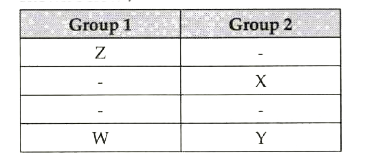The position of three elements A,B and C in the periodic table are shown below

a) State whether A is non metal or metal b) State whether C is more reactive or less reactive than A c) Will C be larger or smaller in size than B .
a) Elements of group 17 have seven electrons in their respective valence shells and thus have a strong tendency to gain one or more electrons to complete their respective octets. Thus C which is an element of group 17 is a non-metal.
b) As we move down the group, the atomic size increase. Therefore, the force of attraction of the nucleus for the incoming electron decreases and hence the reactivity decreases down the group. Since the element C has larger atomic size than the element A, therefore, the element C is less reactive than the element A.
c) Element B and C belong to the same period, i.e, 5th period. As we move from left to right in a period, the nuclear charge increases but the number of shells remains to be the same. Therefore, the size decreases from left to right. Thus, the atomic size of C is smaller than that of B.
Topper's Solved these Questions
- CPC MODEL QUESTION PAPER-4BOOK - CPC CAMBRIDGE PUBLICATIONCHAPTER - CPC MODEL QUESTION PAPER-4EXERCISE - CHOOSE THE CORRECT ANSWER
8 Videos
- CPC MODEL QUESTION PAPER 6BOOK - CPC CAMBRIDGE PUBLICATIONCHAPTER - CPC MODEL QUESTION PAPER 6EXERCISE - ANSWER THE FOLLOWING
37 Videos
- DEPARTMENTAL MODEL QUESTION PAPER - 1BOOK - CPC CAMBRIDGE PUBLICATIONCHAPTER - DEPARTMENTAL MODEL QUESTION PAPER - 1EXERCISE - ANSWER THE FOLLOWING QUESTIONS
36 Videos
Similar Questions
The position of three elements A, B and C in che periodic table are shown below :

(a) State whether A is metal or non-metal.
(b) Seate whether C is more reactive or less reactive than A.
(c) Will C be larger or smaller in size than B ?
(d) Which type of ion, cation or anion will be formed by the element A ?
View SolutionThe position of three elements A, B and C in the Periodic Table are shown below:

(a) State whether A is a metal or a non-metal.
(b) State whether C is more reactive or less reactive than A.
(c) Will C be larger or smaller in size than B?
(d) Which type of ion-cation or anion will be formed by element A?
View SolutionThe positions of three elements A,B and C in the periodic table are shown here
(a) State whether A is a metal or non-metal?

State whether C is more reactive or less reactive than A
(c) Will C be larger or smaller in size than B?
(d) Which type of ion, cation or anion, will be formed by element A?
View SolutionElements W, X, Y, Z in the periodic table are shown below:

State whether Z is metal or non-metal
View SolutionThe position of three elements A, B and C in the Periodic table are shown below :

Will C be larger or smaller in size than B?
View SolutionElements W, X, Y, Z in the periodic table are shown below:

State whether Y is smaller or larger than W
View SolutionThe position of elements A,B,C,D and E in the periodic table are shown below :

State which is the most reactive (i) metal (ii) non metal .
View SolutionThe position of three elements A, B and C in the Periodic Table are shown below :
Group 16Group 17−−−A−−BC
(a) State whether A is a metal or non-metal.
(b) State whether C is more reactive or less reactive than A.
(c) Will C be larger or smaller in size than B?
(d) Which type of ion, cation or anion, will be formed by element A ?
View SolutionThe positions of three elements A, B and C in the periodic table are shown below:
Group 16Group 17−−−A−−BC
State whether C is more reactive or less reactive than A.
View SolutionThe positions of three elements P, Q and R in the periodic table are shown below

Which of these three elements is most non-metallic ?
View Solution
